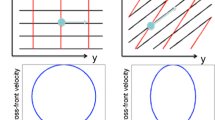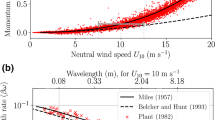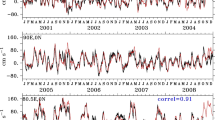Abstract
Parallel with the traditional hypotheses on the predominantly wind (Ekman), gradient, and thermohaline nature of large-scale currents in seas and oceans, there exist hypotheses on the participation of long-period waves in the formation of these currents. As the physical mechanisms of generation of currents by waves, one can mention nonlinear wave transport and the phenomenon of negative viscosity in waves. From the viewpoint of existence of these mechanisms, numerous scientists explain high velocities of jet currents and their stable character. The predominant role of winds and thermohaline processes in the formation of large-scale currents is also accepted. On the basis of the experimental data, we demonstrate additional possibilities for the formation of large-scale currents given by the transport of water masses by long-period waves.
Similar content being viewed by others
REFERENCES
A. L. Bondarenko, Currents of the Caspian Sea and the Formation of Salinity Field in the North Part of the Caspian Sea [in Russian], Nauka, Moscow (1993).
A. L. Bondarenko, “On the nature of quasiconstant currents in the Caspian Sea,” Vodnye Resursy, 25, No.2, 252–254 (1998).
A. L. Bondarenko, “On wind currents in the seas,” Vodnye Resursy, 28, No.1, 110–113 (2001).
A. S. Monin, Oceanology. Physics of the Ocean [in Russian], Vol. 1, Nauka, Moscow (1978).
R. Thompson, “Topographic Rossby waves at a site north of the Gulf Stream,” Deep-Sea Res., 18, No.1, 1–19 (1971).
V. A. Ivanov and A. E. Yankovskii, “Local dynamical experiment in the shelf zone of the South Coast of Crimea,” Okeanologiya, 33, No.1 49–55 (1993).
K. H. Brink and D. C. Chapman, “Programs for computing properties of coastal-trapped waves and wind-driven motions over the continental shelf and slope (second edition),” Technical Report No. WHO187-24 of the Woods Hole Oceanographic Institute, June 1987.
K. H. Brink, “Coastal-trapped waves and wind-driven currents over the continental shelf,” Ann. Rev. Fluid Mech., 23, 289–412 (1991).
A. Gill, Atmosphere-Ocean Dynamics, Academic Press, New York (1982).
A. L. Bondarenko, V. V. Zhmur, Yu. G. Filippov, and V. A. Shchev’ev, “Coastal-trapped waves and quasiconstant currents in closed seas,” in: Proc. of the Sixth Internat. Sci.-Eng. Conf. on Contemporary Methods and Means of Oceanographic Investigations [in Russian], Institute of Oceanology, Russian Academy of Sciences (2000), pp. 182–186.
V. Kh. German and S. P. Levikov, Probability Analysis and Modeling of Oscillations of the Sea Level [in Russian], Gidrometeoizdat, Leningrad (1988).
V. M. Kamenkovich, M. M. Koshlyakov, and A. S. Monin, Synoptic Eddies in the Ocean [in Russian], Gidrometeoizdat, Leningrad (1982).
P. H. Le Blond, and L. A. Mysak, Waves in the Ocean, Elsevier, Amsterdam (1978).
A. S. Monin, V. M. Kamenkovich, and V. G. Kort, Variability of the World Ocean [in Russian], Gidrometeoizdat, Leningrad (1974).
G. K. Korotaev, É. N. Mikhailova, and N. B. Shapiro, Theory of Equatorial Countercurrents in the World Ocean [in Russian], Naukova Dumka, Kiev (1986).
M. J. Lighthill, “Dynamic response of the Indian ocean to onset of the southwest monsoon,” Phil. Trans. R. Soc. Lond. A, 265, 45–92 (1969).
D. L. T. Anderson and P. B. Rowlands, “The Somali Current response of the southwest monsoon: the relative importance of local and remote forcing,” J. Mar. Res., 34, 395–417 (1976).
M. D. Cox, “Equatorially trapped wave and the generation of the Somali Current,” Deep-Sea Res., 23, No.12, 1139–1152 (1976).
J. A. Knauss, “Further measurements and observations on the Cromwell Current,” J. Mar. Res., 24, 205–240 (1966).
S. G. H. Philander, “Equatorial undercurrent, measurements and theories,” Rev. Geophys. Space Phys., 11, 513–570 (1973).
P. P. Niller and L. A. Mysak, “Barotropic waves along an eastern continental shelf,” Geophys. Fluid. Dyn., 2, 273–288 (1971).
W. H. Munk and D. Moore, “Is the Cromwell current driven by equatorial Rossby waves?”, J. Fluid Mech., 33, 241–259 (1968).
M. S. Longuet-Higgins, “On the transport of mass by time-varying ocean currents,” Deep-Sea Res., 16, No.5, 431–447 (1969).
D. Halpern, R. A. Knox, and D. S. Luther, “Observation of 20-day period meridional current oscillations in the upper ocean along the Pacific Equator,” J. Phys. Oceanogr., 18, 1514–1534 (1988).
K. A. Rogachev, “Water opening over the Koshevarov Bank,” Priroda, No. 3, 33–38 (2001).
C. Wunsh, “On the mean drift in large lake,” Limnol. Oceanogr., 18, 793–795 (1973).
Author information
Authors and Affiliations
Additional information
Translated from Morskoi Gidrofizicheskii Zhurnal, No. 5, pp. 24–34, September–October, 2004.
Rights and permissions
About this article
Cite this article
Bondarenko, A.L., Zhmur, V.V., Filippov, Y.G. et al. On the transport of water masses by long-period waves in seas and oceans. Phys Oceanogr 14, 275–283 (2004). https://doi.org/10.1007/s11110-005-0008-3
Received:
Revised:
Issue Date:
DOI: https://doi.org/10.1007/s11110-005-0008-3




